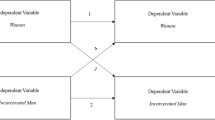Abstract
The purpose of the present study is to examine how conflict resolution styles between one family dyad is related to other family dyads and how conflict resolution styles within these family dyads are related to conflict resolution styles in one relationship outside the family—adolescents' romantic relationships. Late adolescents (n = 217) were asked to report their perceptions of three resolution styles used in interparent, mother–adolescent, father–adolescent, sibling, and romantic couple conflicts. Based on the cases with complete data (n = 163), path analyses indicated that both direct and indirect relationships exist between these dyadic relationships: (1) Resolution styles utilized in the interparent subsystem were found to have a direct relationship with mother–adolescent and father–adolescent resolution and an indirect relationship with sibling and romantic couple resolution. (2) Mother–adolescent and father–adolescent resolution were found to have a direct relationship with sibling and romantic couple resolution. (3) Sibling resolution was found to have a direct relationship with romantic couple resolution for negative resolution styles, but not for the positive resolution style of compromise.
Similar content being viewed by others
REFERENCES
Bandura, A. (1989). Social cognitive theory. Ann. Child Develop. 6: 1–60.
Bollen, K. A. (1989). Structural Equations with Latent Variables. John Wiley & Sons, New York.
Breslin, F. C., Riggs, D. S., O'Leary, K. D., and Aries, I. (1990). Family precursors: Expected and actual consequences of dating aggression. J. Interpers. Vio. 5: 247–258.
Brody, G. H., and Forehand, R. (1993). Prospective associations among family form, family processes, and adolescents' alcohol and drug use. Behav. Res. Ther. 31: 587–593.
Brody, G., Stoneman, Z., McCoy, K., and Forehand, R. (1992). Contemporaneous and longitudinal associations of sibling conflict with family relationship assessment and family discussions about sibling problems. Child Develop. 63: 391–400.
Cole, D. A., and McPherson, A. E. (1993). Relation of family subsystems to adolescent depression: Implementing a new family assessment strategy. J. Family Psychol. 7: 119–133.
DeMaris, A. (1987). The efficacy of a spouse abuse model in accounting for courtship violence. J. Family Issues 8: 291–305.
Foo, L., and Margolin, G. (1995). A multivariate investigation of dating aggression. J. Family Viol. 10: 351–377.
Furman, W., and Buhrmester, D. (1992). Age and sex differences in perceptions of networks of personal relationships. Child Develop. 63: 103–115.
Graham-Bermann, S. A., Cutler, S. E., Litzenberger, B. W., and Schwartz, W. E. (1994). Perceived conflict and violence in childhood sibling relationships and later emotional adjustment. J. Family Psychol. 8: 85–97.
Hartup, W. W. (1993). Conflict and friendship relations. In Shantz, C. U., and Hartup, W. W. (eds.), Conflict in Child and Adolescent Development. Cambridge University Press, New York.
Hotaling, G., and Sugarman, D. (1986). An analysis of risk markers in husband to wife violence: The current state of knowledge. Viol. Victims 1: 101–124.
Katz, L. F., and Gottman, J. M. (1993). Patterns of marital conflict predict childrens' internalizing and externalizing behaviors. Develop. Psychol. 29: 940–950.
Kaufman, J., and Zigler, E. (1987). Do abused children become abusive parents? American J. Orthopsychiat. 57: 186–192.
Mangold, W. D., and Koski, P. R. (1990). Gender comparisons in the relationship between parental and sibling violence and nonfamily violence. J. Family Violence 5: 225–235.
Marshall, L. L., and Rose, R. (1988). Family of origin violence and courtship abuse. J. Counsel. Develop. 66: 414–418.
Marsh, H. W., and Hocevar, D. (1988). A new, more powerful approach to multitrait-multimethod analyses: Application of second-order confirmatory factor analysis. J. Appl. Psychol. 73: 107–117.
Montemayor, R., and Hanson, E. A. (1985). A naturalistic view of conflict between adolescents and their parents and siblings. J. Early Adoles. 3: 83–103.
Rubenstein, J. L., and Feldman, S. E. (1993). Conflict-resolution behavior in adolescent boys: Antecedents and adaptational correlates. J. Res. Adolesc. 3: 41–66.
Sabatelli, R. M., and Bartle, S. E. (1995). Survey approaches to the assessment of family functioning: Conceptual, operational, and analytical issues. J. Marriage Family 57: 1025–1039.
Shantz, C. U. (1987). Conflicts between children. Child Development 58: 238–305.
Shantz, C. U., and Hartup, W. W. (1992). Conflict in Child and Adolescent Development. Cambridge University Press, New York.
Truscott, D. (1992). Intergenerational transmission of violent behavior in adolescent males. Aggres. Behav. 18: 327–335.
von Bertalanffy, L. (1968). General System Theory. George Braziller, New York.
Author information
Authors and Affiliations
Rights and permissions
About this article
Cite this article
Reese-Weber, M., Bartle-Haring, S. Conflict Resolution Styles in Family Subsystems and Adolescent Romantic Relationships. Journal of Youth and Adolescence 27, 735–752 (1998). https://doi.org/10.1023/A:1022861832406
Issue Date:
DOI: https://doi.org/10.1023/A:1022861832406




